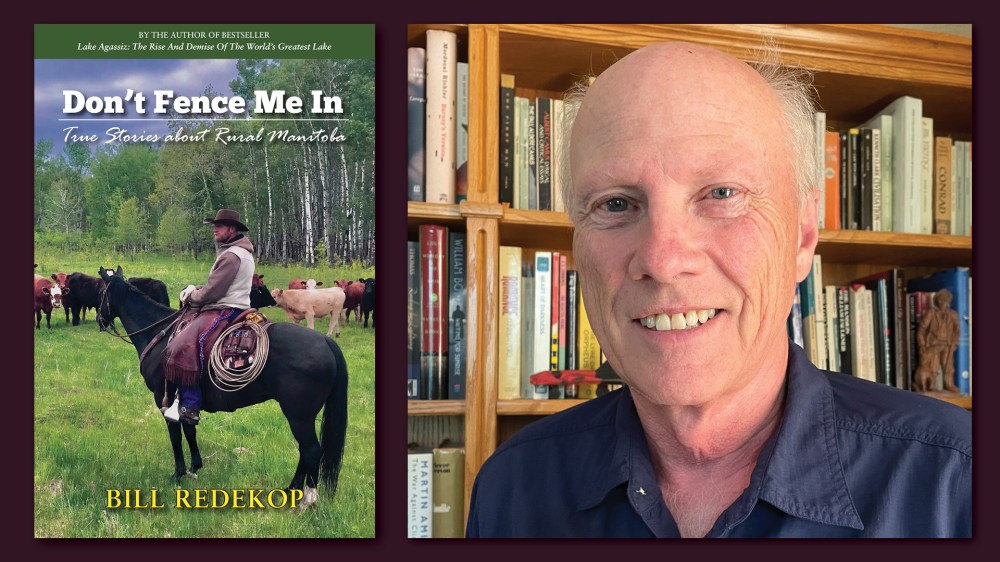Former reporter shares stories of rural Manitoba
Advertisement
Hey there, time traveller!
This article was published 26/10/2023 (622 days ago), so information in it may no longer be current.
A four-year labour of love about rural Manitoba has been released in book form and author Bill Redekop wants it to be a thank you to the communities he covered as a Winnipeg Free Press reporter.
“I just had a whole bunch of stories left over from my Free Press days and stories that I wasn’t able to do for one reason or another. And thought they were great stories and for a reporter you’re just compelled. If you think you know some good stories it’s really driving force,” he said.
For 14 years, Redekop was the rural initiatives reporter covering everything interesting outside the perimeter of Winnipeg.

“I think it’s almost like, ‘Thou shall not cross the perimeter highway!’ I think people need to get out and explore rural Manitoba and learn more about it. I think there’s a lot of ignorance about life beyond the perimeter and hopefully this book helps with that and helps to inform people and also to appreciate what goes on.”
Redekop has 24 stories in Don’t Fence Me In: True Stories about Rural Manitoba. One of those stories is titled The Burning Mountain and centers around leaking natural gas in Notre Dame de Lourdes. About 100 years ago, they were digging a well for water when they happened upon the natural gas leak. Since it wasn’t enough to heat their home, the owners of the land covered it. Come to today, a farmer named Normand Bosc has a pipe running right out of the well.
“He has a pipe running right out of it and he has a spigot coming at the end of that pipe and it’s like a flame thrower, it’ll shoot flame five meters high. For me I had always wanted to go out and see this and do this story. And for various reasons I wasn’t allowed at the Free Press so it was like a big thing for me to go out and see this. It’s amazing! We don’t think of Manitoba as having natural gas, but in fact we do. We’re not sure if we have enough to make it economically viable to extract it, (but it’s there).”
Another story Redekop shared that might be of interest to Southeastern readers was an ancient now extinct glacial lake, Lake Vita. The lake existed 30,000 to 40,000 years ago and covered Vita, Steinbach, Grunthal, Stuartburn, Gardenton, Tolstoi, Roseau River Ojibway Nation, and Dominion City.
“Preliminary estimates are the lake was at least 30 km wide and 40 km long, or 840 square kilometres. At minimum, Lake Vita was the size of Cedar Lake, Manitoba’s eighth largest lake, located north of Lake Winnipegosis, and was twice the size of Dauphin Lake,” read an excerpt from the book.
During his Free Press days, Redekop said he felt like a bridge between the urban world and rural world. In his book he refers to people who live in rural communities as remainers and those who come back to rural life as returners.
“There’s a term in academia called post-rural. And post-rural is a study of rural North America and it’s mainly a study of disappearing (population). But I take it that between the remainers – people who stubbornly want to stay on the land and live the lifestyle and newcomers who idealize rural life, and rightly so, and who think that really suits them and immigration. These things are all invigorating. I don’t see rural Manitoba as in decline the way the post-rural study would seem to indicate (in a general way). There’s a lot happening in rural Manitoba,” he said.
Redekop’s next books to be published will be The Life and Legacy of Commodore D.A. Ritchie due out this fall, and The Princess Auto Story due in spring of 2024.
Those who are interested in buying Don’t Fence Me In: True Stories about Rural Manitoba can do so at the Mennonite Heritage Village gift shop, the St Pierre Pharmacy, McNally Robinson, and through Redekop’s Facebook account. Those who buy from his Facebook account won’t need to pay for shipping.
